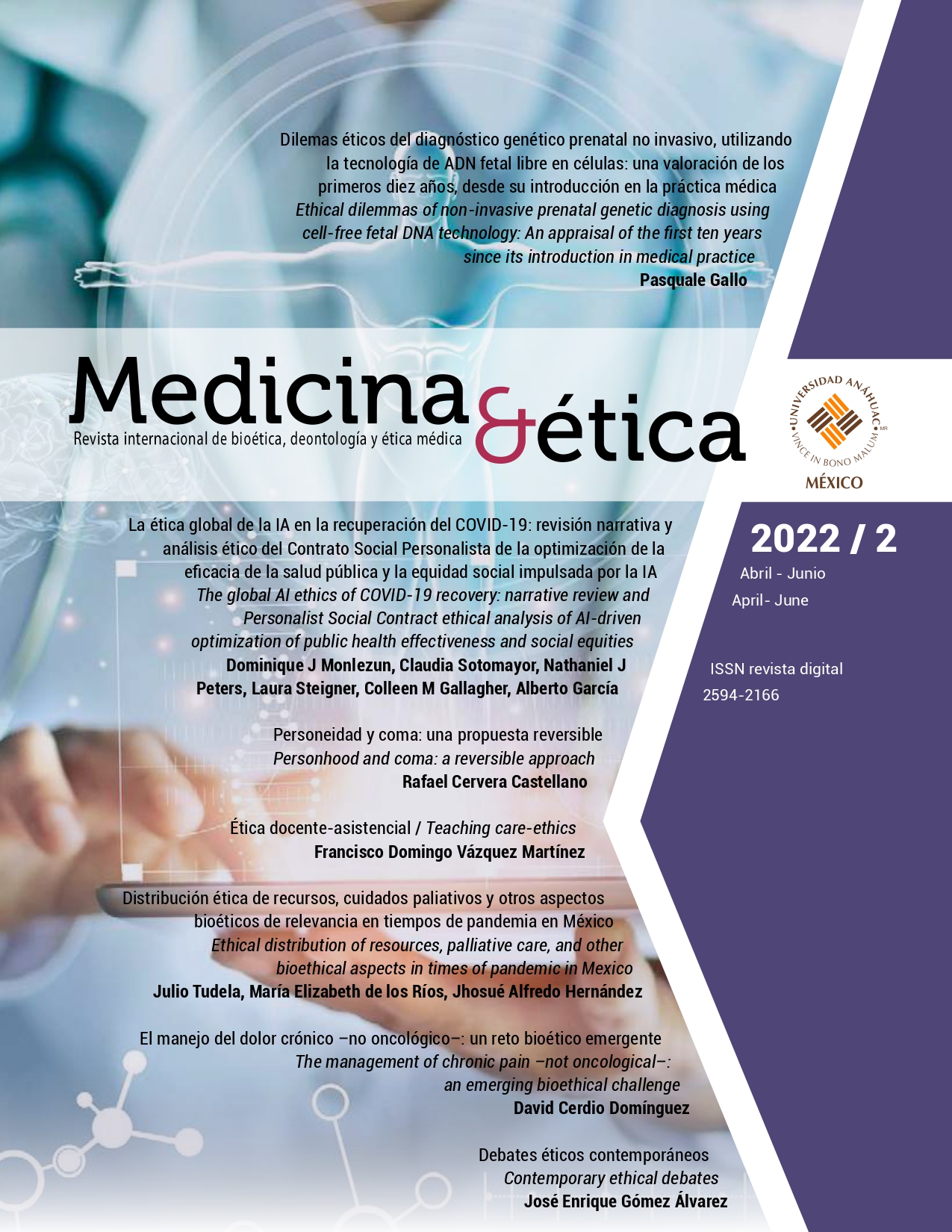El manejo del dolor crónico –no oncológico–: un reto bioético emergente
DOI:
https://doi.org/10.36105/mye.2022v33n2.06Palabras clave:
opioides, interdisciplinar, dignidad humana, sufrimientoResumen
El dolor y el sufrimiento son realidades sustanciales de la experiencia humana. Hoy se comienza a concienciar en cuanto a la realidad contextual del problema sanitario generado como consecuencia de la sociedad líquida y del descarte que se ha heredado. La bioética, como campo interdisciplinar, tiene un papel fundamental y crucial en la orientación y guía de las ciencias de la salud. Analizar y comprender dichos conceptos (dolor y sufrimiento) es elemental para, entonces, poder plantear –proactivamente– estrategias puntuales que favorezcan y promuevan un adecuado tratamiento multidimensional. La presente revisión sistemática tiene como finalidad presentar una visión global y actual en cuanto a la percepción que tanto el dolor crónico como el sufrimiento representan para la sociedad moderna. Epidemiológicamente, se vive una epidemia silente en este sentido, la cual, de no ser abordada integralmente, representa un factor de riesgo para el desarrollo de problemáticas sociales, en combinación con los reduccionismos antropológicos que rigen contemporáneamente.
Descargas
Referencias
Burgos JM. Antropología Breve. Palabra E, editor. España: Ediciones Palabra; 2010.
Bauman Z. Vida Líquida. Austral; 2013.
Emmerich N. What is Bioethics? Medicine, Health Care and Philosophy. 2015; 18(3): 437-441. https://doi.org/10.1007/s11019-015-9628-7
Christopher MJ. It’s time for bioethics to see chronic pain as an ethical issue. Am J Bioeth. 2011; 11(6): 3-4. https://doi.org/10.1080/15265161.2011.589282
Yýldýrým G, Ertekin Pýnar Þ, Gürsoy S, Özdemir Kol I. Views of algology in patients about ethical issues related to pain. Agri. 2019; 31(3): 122-131. https://doi.org/10.14744/agri.2019.80378
Covarrubias AO, Templos ML, et al. Antecedentes de la medicina paliativa en México: Educación continua en cuidados paliativos. Rev Mex Anest. 2019; 42(2): 122-128.
Del Río IP A. Cuidados Paliativos: Historia y desarrollo. Boletín Escuela de Medicina UC. 2007; 32(1): 16-22.
Sgreccia E. Human person and personalism. Cuad Bioet. 2013; 24(80): 115-123.
Giordano J, Schatman ME. An ethical analysis of crisis in chronic pain care: Facts, issues and problems in pain medicine; Part I. Pain Physician. 2008; 11(4): 483-490. https://doi.org/10.36076/ppj.2008/11/483
Giordano J, Schatman ME. A crisis in chronic pain care: An ethical analysis. Part two: Proposed structure and function of an ethics of pain medicine. Pain Physician. 2008; 11(5): 589-595. https://doi.org/10.36076/ppj.2008/11/589
Giordano J, Schatman ME. A crisis in chronic pain care: An ethical analysis. Part three: Toward an integrative, multi-disciplinary pain medicine built around the needs of the patient. Pain Physician. 2008; 11(6): 775-784. https://doi.org/10.36076/ppj.2008/11/775
Ibarra E. Una nueva definición de dolor. Un imperativo en nuestros días. Rev Soc Esp Dolor. 2006; 13(2): 65-72.
Raja SN, Carr DB, Cohen M, Finnerup NB, Flor H, Gibson S, et al. The revised International Association for the Study of Pain definition of pain: Concepts, challenges, and compromises. Pain. 2020; 161(9): 1976-1982. https://doi.org/10.1097/j.pain.0000000000001939
Karches KE. The ends of medicine and the crisis of chronic pain. Theoretical Medicine and Bioethics. 2019; 40(3): 183-196. https://doi.org/10.1007/s11017-019-09489-6
Jennings N, Chambaere K, Macpherson CC, Deliens L, Cohen J. Main themes, barriers, and solutions to palliative and end-of-life care in the English-speaking Caribbean: A scoping review. Rev Panam Salud Pública. 2018; 42: e15. https://doi.org/10.26633/RPSP.2018.15
Gevaert J. El problema del hombre. Sígueme, editor. España: Sígueme; 2001.
García J. Manejo básico del dolor agudo y crónico. Anestesia en Méx. 2017; 29(1): 77-85.
Crofford LJ. Chronic Pain: Where the body meets the brain. Trans Am Clin Climatol Assoc. 2015; 126: 167-183.
Maixner W, Fillingim RB, Williams DA, Smith SB, Slade GD. Overlapping chronic pain conditions: Implications for diagnosis and classification. J Pain. 2016; 17(9 Suppl): T93-t107. https://doi.org/10.1016/j.jpain.2016.06.002
Linton SJ, Flink IK, Vlaeyen JWS. Understanding the etiology of chronic pain from a psychological perspective. Phys Ther. 2018; 98(5): 315-324. https://doi.org/10.1093/ptj/pzy027
Takai Y, Yamamoto-Mitani N, Abe Y, Suzuki M. Literature review of pain management for people with chronic pain. Jpn J Nurs Sci. 2015; 12(3): 167-183. https://doi.org/10.1111/jjns.12065
Astudillo WM C, Astudillo E, Gabilondo S. Principios básicos para el control del dolor total. Rev Soc Esp Dolor. 1998; 6(1): 29-40.
Fillingim RB, Loeser JD, Baron R, Edwards RR. Assessment of chronic pain: Domains, methods, and mechanisms. J Pain. 2016; 17(9 Suppl): T10-20. https://doi.org/10.1016/j.jpain.2015.08.010
Ahmadi A, Bazargan-Hejazi S, Heidari Zadie Z, Euasobhon P, Ketumarn P, Karbasfrushan A, et al. Pain management in trauma: A review study. J Inj Violence Res. 2016; 8(2): 89-98. https://doi.org/10.5249/jivr.v8i2.707
Foster NE, Anema JR, Cherkin D, Chou R, Cohen SP, Gross DP, et al. Prevention and treatment of low back pain: Evidence, challenges, and promising directions. Lancet. 2018; 391(10137): 2368-2383. https://doi.org/10.1016/S0140-6736(18)30489-6
Coluzzi F, Mattia C. Oxycodone. Pharmacological profile and clinical data in chronic pain management. Minerva Anestesiol. 2005; 71(7-8): 451-460.
Domenichiello AF, Ramsden CE. The silent epidemic of chronic pain in older adults. Prog Neuropsychopharmacol Biol Psychiatry. 2019; 93: 284-290. https://doi.org/10.1016/j.pnpbp.2019.04.006
Radbruch L, De Lima L, Knaul F, Wenk R, Ali Z, Bhatnaghar S, et al. Redefining palliative care. A new consensus-based definition. J Pain Symptom Manage. 2020; 60(4): 754-764. https://doi.org/10.1016/j.jpainsymman.2020.04.027
Smith BH, Fors EA, Korwisi B, Barke A, Cameron P, Colvin L, et al. The IASP classification of chronic pain for ICD-11: Applicability in primary care. Pain. 2019; 160(1): 83-87. https://doi.org/10.1097/j.pain.0000000000001360
Shapiro RS. Liability issues in the management of pain. J Pain Symptom Manage. 1994; 9(3): 146-152. https://doi.org/10.1016/0885-3924(94)90123-6
Barragán AM, S. Gutiérrez, LM. Dolor en adultos mayores de 50 años: Prevalencia y factores asociados. Salud Pública Mex. 2007; 49(1): 488-494. https://doi.org/10.1590/S0036-36342007001000008
Morrone LA, Scuteri D, Rombola L, Mizoguchi H, Bagetta G. Opioids resistance in chronic pain management. Current Neuropharmacology. 2017; 15(3): 444-456. https://doi.org/10.2174/1570159X14666161101092822
Llaca-García E. La pandemia de COVID-19 en México: El papel fundamental de los cuidados paliativos y bioética. En: Templos-Esteban LA, editor. México: Medicina y Ética; 2021; 179-195. https://doi.org/10.36105/mye.2021v32n1.05
Brennan F, Lohman D, Gwyther L. Access to pain management as a human right. American Journal of Public Health. 2019; 109(1): 61-65. https://doi.org/10.2105/AJPH.2018.304743
Carr DB, Fox DM, Rothstein MA, Spellman CM. Pain Management and public health: Introduction to the special section. Am J Public Health. 2019; 17-18. https://doi.org/10.2105/AJPH.2018.304841
Leppla IE, Gross MS. Optimizing medication treatment of opioid use disorder during COVID-19 (SARS-CoV-2). J Addict Med. 2020; 14(4): e1-e3. https://doi.org/10.1097/ADM.0000000000000678
Bhadelia A, De Lima L, Arreola-Ornelas H, Kwete XJ, Rodríguez NM, Knaul FM. Solving the global crisis in access to pain relief: Lessons from country actions. American Journal of Public Health. 2019; 109(1): 58-60. https://doi.org/10.2105/AJPH.2018.304769
Hadler RA, Rosa WE. Distributive justice: An ethical priority in global palliative care. Journal of Pain and Symptom Management. 2018; 55(4): 1242-1245. https://doi.org/10.1016/j.jpainsymman.2017.12.483
Knaul FM. Disparities and crisis: Access to opioid medicines in Mexico. Lancet Public Health. 2021; 6(2): e83-e4.
https://doi.org/10.1016/S2468-2667(21)00009-8
Zylicz Z. The changing face of palliative care. Advances in palliative medicine. 2011; 10(3/4): 85-88.
Haverfield MC, Giannitrapani K, Timko C, Lorenz K. Patient-Centered pain management communication from the patient perspective. J Gen Intern Med. 2018; 33(8): 1374-1380. https://doi.org/10.1007/s11606-018-4490-y
Sullivan MD, Vowles KE. Patient action: As means and end for chronic pain care. Pain. 2017; 158(8): 1405-1407. https://doi.org/10.1097/j.pain.0000000000000921
Crofford LJ. Psychological aspects of chronic musculoskeletal pain. Best Pract Res Clin Rheumatol. 2015; 29(1): 147-155. https://doi.org/10.1016/j.berh.2015.04.027
Edwards RR, Dworkin RH, Sullivan MD, Turk DC, Wasan AD. The role of psychosocial processes in the development and maintenance of chronic pain. J Pain. 2016; 17(9 Suppl): T70-92. https://doi.org/10.1016/j.jpain.2016.01.001
Ferrer U. Interdisciplinariedad de la bioética: Su posibilidad y sus límites. Cuadernos de Bioética. 2013; XXIV(2): 265-274.
Pastor LM. From virtue bioethics to bioethics personalistic: Is integration possible? Cuad Bioet. 2013; 24(80): 49-56.
Souza LA, Pessoa AP, Barbosa MA, Pereira LV. The bioethical principlism model applied in pain management. Rev Gaucha Enferm. 2013; 34(1): 187-195. https://doi.org/10.1590/S1983-14472013000100024
Millás-Mur J. Ética y bioética en el pregrado de medicina: Una propuesta. Revista Peruana de Medicina Experimental y Salud Pública. 2019; 36: 93-99. https://doi.org/10.17843/rpmesp.2019.361.4260
Compagnone C, Tagliaferri F, Allegri M, Fanelli G. Ethical issues in pain and omics research. Some points to start the debate. Croat Med J. 552014, p. 1-2.
Matthias MS, Bair MJ. The patient-provider relationship in chronic pain management: Where do we go from here? Pain Med. 2010; 11(12): 1747-1749. https://doi.org/10.1111/j.1526-4637.2010.00998.x
Henry SG, Holt ZB. Frustrated patients and fearful physicians. J Gen Intern Med. 322017, p. 148-149. https://doi.org/10.1007/s11606-016-3868-y
Guerra López R. Bioethics and rationality. Personalism at the service of expanding the horizon of reason at the foundation of bioethics. Cuad Bioet. 2013; 24(80): 39-48.
D’Hotman D, Pugh J, Douglas T. When is coercive methadone therapy justified? Bioethics. 2018; 32(7): 405-413. https://doi.org/10.1111/bioe.12451
Kaebnick GE. Bioethics and addiction. Hastings Center Report. 2020; 50(4): 2. https://doi.org/10.1002/hast.1165
Rieder TN. Opioids and ethics: Is opioid-free the only responsible arthroplasty? Hss J. 152019, p. 12-16. https://doi.org/10.1007/s11420-018-9651-3
Pati NB, Gupta VRM, Mayasa V, Velivela MDS, Hussain A. Rethinking chronic pain treatment with opioids. Indian Journal of Pharmaceutical Sciences. 2017; 79(6): 849-857. https://doi.org/10.4172/pharmaceutical-sciences.1000301
Rodrigues P, Crokaert J, Gastmans C. Palliative sedation for existential suffering: A systematic review of argument-based ethics literature. Journal of Pain and Symptom Management. 2018; 55(6): 1577-1590. https://doi.org/10.1016/j.jpainsymman.2018.01.013
Becker WC, Bair MJ, Picchioni M, Starrels JL, Frank JW. Pain management for primary care providers: A narrative review of high-impact studies, 2014-2016. Pain Med. 2018; 19(1): 40-49. https://doi.org/10.1093/pm/pnx146
Carvalho AS, Pereira SM, Jacomo A, Magalhaes S, Araujo J, Hernández Marrero P, et al. Ethical decision making in pain management: A conceptual framework. Journal of Pain Research. 2018; 11: 967-976. https://doi.org/10.2147/JPR.S162926
Saulnier KM. Telling, Hearing, and Believing: A critical analysis of narrative bioethics. Journal of Bioethical Inquiry. 2020; 17(2): 297-308. https://doi.org/10.1007/s11673-020-09973-y
Kaebnick GE. Bioethics and Addiction. Hastings Cent Rep. 2020; 50(4): 2. https://doi.org/10.1002/hast.1165
Bandini JI, Courtwright AM, Rubin E, Erler KS, Zwirner M, Cremens MC, et al. Ethics consultations related to opioid use disorder. Psychosomatics. 2020; 61(2): 161-170. https://doi.org/10.1016/j.psym.2019.10.003
Gudat H, Ohnsorge K, Streeck N, Rehmann-Sutter C. How palliative care patients feelings of being a burden to others can motivate a wish to die. Moral challenges in clinics and families. Bioethics. 2019; 33(4): 421-430. https://doi.org/10.1111/bioe.12590
García LF, Fernandes MS, Moreno JD, Goldim JR. Mapping Bioethics in Latin America: History, theoretical models, and scientific output. J Bioeth Inq. 2019; 16(3): 323-331. https://doi.org/10.1007/s11673-019-09903-7
Sgreccia E. La persona y el respeto por la vida humana. 1997.
Wilson D. What can history do for bioethics? Bioethics. 2013; 27(4): 215-223.
https://doi.org/10.1111/j.1467-8519.2011.01933.x
Cortina A. La dimensión pública de las éticas aplicadas. España: Revista Iberoamericana; 2002, p. 45-64. https://doi.org/10.35362/rie290950
Beauchamp T, Childress J. Principles of Biomedical Ethics: Marking its fortieth anniversary. Am J Bioeth. 2019; 19(11): 9-12. https://doi.org/10.1080/15265161.2019.1665402
Varsi C, Ledel Solem IK, Eide H, Børøsund E, Kristjansdottir OB, Heldal K, et al. Health care providers’ experiences of pain management and attitudes towards digitally supported self-management interventions for chronic pain: A qualitative study. BMC Health Services Research. 2021; 21(1): 1-16. https://doi.org/10.1186/s12913-021-06278-7
Cameron F, Janze A, Klarare A. Homecoming-Dignity through movement at the end of life: A qualitative interview study with healthcare professionals. Am J Hosp Palliat Care. 2021: 10499091211017876. https://doi.org/10.1177/10499091211017876
Balboni MJ, Sullivan A, Smith PT, Zaidi D, Mitchell C, Tulsky JA, et al. The views of clergy regarding ethical controversies in care at the end of life. Journal of Pain and Symptom Management. 2018; 55(1): 65+. https://doi.org/10.1016/j.jpainsymman.2017.05.009
Black E, Khor KE, Demirkol A. Responsible prescribing of opioids for chronic non-cancer pain: A scoping review. Pharmacy. 2020; 8(3).
https://doi.org/10.3390/pharmacy8030150
Bushnell MC, Ceko M, Low LA. Cognitive and emotional control of pain and its disruption in chronic pain. Nat Rev Neurosci. 2013; 14(7): 502-511. https://doi.org/10.1038/nrn3516
Kohrt BA, Griffith JL, Patel V. Chronic pain and mental health: Integrated solutions for global problems. Pain. 2018; 159 Suppl 1(Suppl 1): s85-s90. https://doi.org/10.1097/j.pain.0000000000001296
Adamou N, Tukur J, Muhammad Z, Galadanci H. A randomised controlled trial of opioid only versus combined opioid and non-steroidal anti inflammatory analgesics for pain relief in the first 48 hours after Caesarean section. Niger Med J. 2014; 55(5): 369-373. https://doi.org/10.4103/0300-1652.140319
Adeniji AO, Atanda OO. Randomized comparison of effectiveness of unimodal opioid analgesia with multimodal analgesia in post-cesarean section pain management. J Pain Res. 2013; 6: 419-424. https://doi.org/10.2147/JPR.S44819
Calvo-Alén J. Opioids in chronic musculoskeletal conditions. Ther Adv Musculoskelet Dis. 2010; 2(5): 291-297. https://doi.org/10.1177/1759720X10370237
Saigal AN, Jones HM. Interdisciplinary mitigation of opioid misuse in musculoskeletal patients. Hss J. 2019; 15(1): 72-75. https://doi.org/10.1007/s11420-018-09656-w
Smith HS, Peppin JF. Toward a systematic approach to opioid rotation. J Pain Res. 2014; 7: 589-608. https://doi.org/10.2147/JPR.S55782
Rieder TN. The Perilous Blessing of Opioids. Mo Med. 2020; 117(3): 202-203.
Descargas
Publicado
Número
Sección
Licencia

Esta obra está bajo una licencia internacional Creative Commons Atribución-NoComercial-CompartirIgual 4.0.
Medicina y Ética se distribuye bajo Licencia Creative Commons Atribución-NoComercial-CompartirIgual 4.0 Internacional.
El autor conserva los derechos patrimoniales sin restricciones y garantiza a la revista el derecho de ser la primera publicación del trabajo. El autor es libre de depositar la versión publicada en cualquier otro medio, como un repositorio institucional o en su propio sitio web.



























